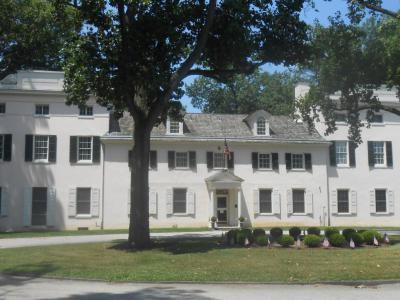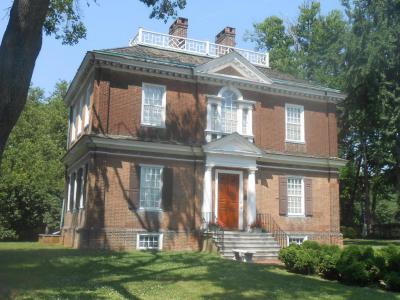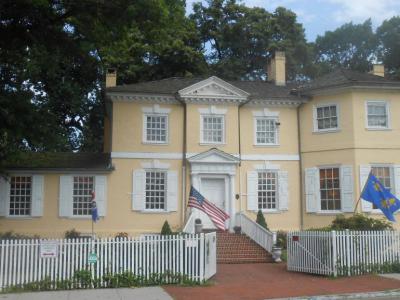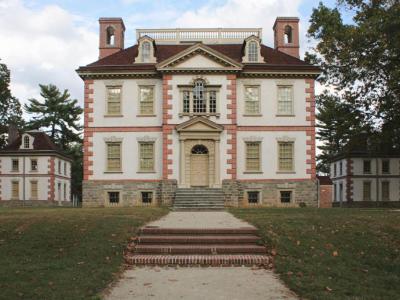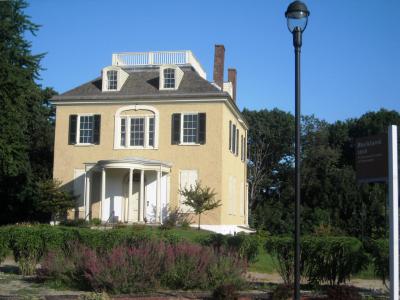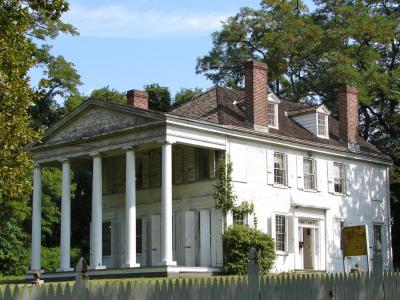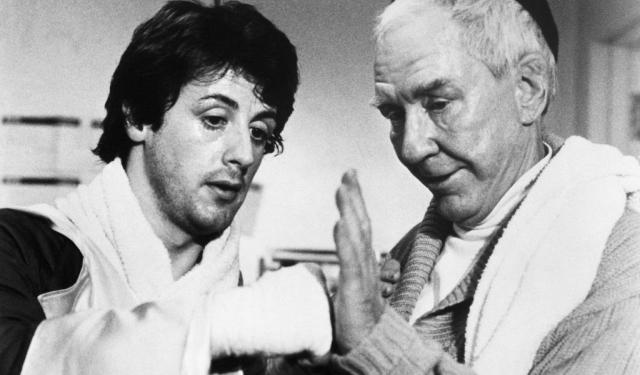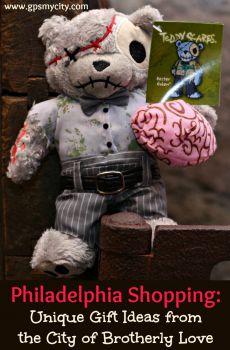Fairmount Park Historical Houses Walking Tour (Self Guided), Philadelphia
Fairmount Park, Philadelphia's oldest park, established since 1867, is also the city's largest municipal park, sprawling over 2,000 acres adjacent to the banks of the Schuylkill River. The park grew out of the Lemon Hill estate of Henry Pratt, whose land was originally owned by Robert Morris, signer of the Declaration of Independence.
In 1972, the park was placed on the National Register of Historic Places.
This was partly due to the multiple historic houses located within the area and affectionately known as the "Charms of Fairmount Park" or simply "Park Charms". Designed and used as private residences, most of these properties are referred to as mansions (Woodford Mansion, Strawberry Mansion, Ormiston Mansion) due to their size and former use as the summer country estates by affluent Philadelphian citizens around the time of the American Revolution.
Back then, the city's only developed areas were located several miles away to the southeast along the Delaware River, making the current park territory an ideal refuge from epidemics during the summer months. The mansions were built between the latter half of the 18th century (Randolph House, c. 1767) and early 19th century (Rockland Mansion, c. 1810), and their architecture features a variety (and sometimes combination) of styles including Colonial Revival, Federal, Georgian, Gothic Revival, Greek Revival, and Palladian.
The majority of historic dwellings still extant were constructed within the current park boundaries, while the others, such as Hatfield House, were moved here from elsewhere in the city. The likes of Mount Pleasant, built in 1762–65 for a Scottish ship captain and currently administered by the Philadelphia Museum of Art, are among the most significant architectural examples of that period in the history of the United States.
If you want to learn more about and get a closer view of the Park Charms yourself, take this self-guided walking tour.
In 1972, the park was placed on the National Register of Historic Places.
This was partly due to the multiple historic houses located within the area and affectionately known as the "Charms of Fairmount Park" or simply "Park Charms". Designed and used as private residences, most of these properties are referred to as mansions (Woodford Mansion, Strawberry Mansion, Ormiston Mansion) due to their size and former use as the summer country estates by affluent Philadelphian citizens around the time of the American Revolution.
Back then, the city's only developed areas were located several miles away to the southeast along the Delaware River, making the current park territory an ideal refuge from epidemics during the summer months. The mansions were built between the latter half of the 18th century (Randolph House, c. 1767) and early 19th century (Rockland Mansion, c. 1810), and their architecture features a variety (and sometimes combination) of styles including Colonial Revival, Federal, Georgian, Gothic Revival, Greek Revival, and Palladian.
The majority of historic dwellings still extant were constructed within the current park boundaries, while the others, such as Hatfield House, were moved here from elsewhere in the city. The likes of Mount Pleasant, built in 1762–65 for a Scottish ship captain and currently administered by the Philadelphia Museum of Art, are among the most significant architectural examples of that period in the history of the United States.
If you want to learn more about and get a closer view of the Park Charms yourself, take this self-guided walking tour.
How it works: Download the app "GPSmyCity: Walks in 1K+ Cities" from Apple App Store or Google Play Store to your mobile phone or tablet. The app turns your mobile device into a personal tour guide and its built-in GPS navigation functions guide you from one tour stop to next. The app works offline, so no data plan is needed when traveling abroad.
Fairmount Park Historical Houses Walking Tour Map
Guide Name: Fairmount Park Historical Houses Walking Tour
Guide Location: USA » Philadelphia (See other walking tours in Philadelphia)
Guide Type: Self-guided Walking Tour (Sightseeing)
# of Attractions: 7
Tour Duration: 2 Hour(s)
Travel Distance: 4.7 Km or 2.9 Miles
Author: DanaOffice
Sight(s) Featured in This Guide:
Guide Location: USA » Philadelphia (See other walking tours in Philadelphia)
Guide Type: Self-guided Walking Tour (Sightseeing)
# of Attractions: 7
Tour Duration: 2 Hour(s)
Travel Distance: 4.7 Km or 2.9 Miles
Author: DanaOffice
Sight(s) Featured in This Guide:
- Historic Strawberry Mansion
- Woodford Mansion
- Laurel Hill Mansion
- Ormiston Mansion
- Rockland Mansion
- Mount Pleasant Mansion
- Hatfield House
1) Historic Strawberry Mansion
Historic Strawberry Mansion, originally named Summerville, serves as a summer residence with a rich history. It was constructed by Judge William Lewis, who acquired the land in what is now Fairmount Park. The mansion was built sometime between 1783 and 1789, and Judge Lewis resided there until his passing in 1819.
Following Judge Lewis's death, Joseph Hemphill became the owner of the mansion. The Hemphill family made significant alterations to the original Federal-style structure by adding Greek Revival wings around 1828.
In 1867, the city acquired the mansion and a substantial portion of the surrounding land to safeguard the Schuylkill River, which served as the city's drinking water source. This initiative led to the establishment of East Fairmount Park.
The Philadelphia Museum of Art and the Fairmount Park Commission oversaw the renovation of Strawberry Mansion, which was transformed into a museum and a welcoming venue by the Committee of 1926. This committee was composed of various women's clubs that collaborated to create a Sesquicentennial Exposition in South Philadelphia, celebrating the 150th anniversary of the Declaration of Independence.
Funding for the restoration project was generously provided by Joseph Horn, who had roots in the Philadelphia area and had fond childhood memories of playing in the park. Women's organizations from across the city contributed exceptional period furnishings to adorn the mansion's rooms.
The mansion officially reopened its doors in 1931. To this day, the Committee of 1926 continues to preserve the historic property and uphold the values of hospitality on which it was established. The most recent restoration of the building occurred in the early 21st century.
Following Judge Lewis's death, Joseph Hemphill became the owner of the mansion. The Hemphill family made significant alterations to the original Federal-style structure by adding Greek Revival wings around 1828.
In 1867, the city acquired the mansion and a substantial portion of the surrounding land to safeguard the Schuylkill River, which served as the city's drinking water source. This initiative led to the establishment of East Fairmount Park.
The Philadelphia Museum of Art and the Fairmount Park Commission oversaw the renovation of Strawberry Mansion, which was transformed into a museum and a welcoming venue by the Committee of 1926. This committee was composed of various women's clubs that collaborated to create a Sesquicentennial Exposition in South Philadelphia, celebrating the 150th anniversary of the Declaration of Independence.
Funding for the restoration project was generously provided by Joseph Horn, who had roots in the Philadelphia area and had fond childhood memories of playing in the park. Women's organizations from across the city contributed exceptional period furnishings to adorn the mansion's rooms.
The mansion officially reopened its doors in 1931. To this day, the Committee of 1926 continues to preserve the historic property and uphold the values of hospitality on which it was established. The most recent restoration of the building occurred in the early 21st century.
2) Woodford Mansion
Woodford Mansion stands as the earliest of Philadelphia's grand colonial-era homes in the local vicinity, showcasing the affluence of the late-Georgian period. Its construction spanned from 1756 to 1758, encompassing an expansive 12-acre plot (approximately 49,000 square meters). The mansion served as a modest 1½-story summer retreat for William Coleman, a prosperous merchant and a justice of the Pennsylvania Supreme Court.
Following Coleman's passing in 1769, the property changed hands and was acquired by Alexander Barclay, a Quaker who held the position of His Majesty's Customs Comptroller for the Philadelphia port. Tragically, Barclay passed away in 1771, and the mansion subsequently fell into the ownership of his brother-in-law, David Franks. Franks, in 1772, embarked on a significant expansion project, adding a second story and a kitchen wing to the structure, nearly achieving its current size.
In 1869, the city took ownership of Woodford, incorporating it into Fairmount Park. Over the years, the mansion served various roles, initially as the residence of the Park's Chief Engineer and Supervisor, and later, in 1912, as the headquarters for the Park Guard and a traffic court.
In 1927, restoration efforts were initiated, culminating in 1930 when Woodford opened its doors to the public as a house museum, a status it continues to hold. Managed by the Naomi Wood Trust, the museum now houses the Naomi Wood collection of antique household items, featuring Colonial-era furniture, unique timepieces, and English delftware.
Notably, Woodford is recognized as a contributing property within the Fairmount Park Historic District, receiving the prestigious designation of a National Historic Landmark in 1967.
Following Coleman's passing in 1769, the property changed hands and was acquired by Alexander Barclay, a Quaker who held the position of His Majesty's Customs Comptroller for the Philadelphia port. Tragically, Barclay passed away in 1771, and the mansion subsequently fell into the ownership of his brother-in-law, David Franks. Franks, in 1772, embarked on a significant expansion project, adding a second story and a kitchen wing to the structure, nearly achieving its current size.
In 1869, the city took ownership of Woodford, incorporating it into Fairmount Park. Over the years, the mansion served various roles, initially as the residence of the Park's Chief Engineer and Supervisor, and later, in 1912, as the headquarters for the Park Guard and a traffic court.
In 1927, restoration efforts were initiated, culminating in 1930 when Woodford opened its doors to the public as a house museum, a status it continues to hold. Managed by the Naomi Wood Trust, the museum now houses the Naomi Wood collection of antique household items, featuring Colonial-era furniture, unique timepieces, and English delftware.
Notably, Woodford is recognized as a contributing property within the Fairmount Park Historic District, receiving the prestigious designation of a National Historic Landmark in 1967.
3) Laurel Hill Mansion
Laurel Hill Mansion, historically known as Randolph House, is a significant historic mansion located in East Fairmount Park in Philadelphia, with a rich and complex history.
The mansion's origins are subject to conflicting accounts. Some believe it was constructed in 1748 by Joseph Shute and later purchased by Francis Rawle as a summer retreat for his family. However, the organization managing the property claims that Francis Rawle bought the land in 1760. Following Rawle's death in a shooting accident in 1761, his wife, Rebecca, oversaw the construction of Laurel Hill. The couple had three children: Anna, William, and Margaret.
Rebecca married Samuel Shoemaker, who later became the mayor of Philadelphia. The Shoemakers owned Laurel Hill and other properties. Samuel fled to England as a British Loyalist, resulting in Laurel Hill being sold at auction. Rebecca regained ownership by 1791 and, upon her death in 1819, her son William inherited it. He sold it to Dr. Philip Syng Physick, a renowned surgeon. The house passed to Physick's daughter, Sally Randolph, and became Randolph Mansion or Randolph House. In 1976, during the Bicentennial, Philadelphia renamed it Laurel Hill Mansion.
Architecturally, the central portion of the mansion, built around 1767, showcases the Georgian style. It was expanded in the early 19th century with a one-story addition to the south. In 1846, an octagonally-shaped Federal style addition was constructed on the north side.
The house is filled with portraits of past residents and 18th-century decor, including an heirloom 18th-century Philadelphia Chippendale mahogany highboy gifted by the Rawle family in 1993. There are also musical instruments like an 1808 Broadwood pianoforte and an early 19th-century harp.
The mansion was officially recognized for its historical significance when it was added to the National Register of Historic Places on March 24, 1972.
The mansion's origins are subject to conflicting accounts. Some believe it was constructed in 1748 by Joseph Shute and later purchased by Francis Rawle as a summer retreat for his family. However, the organization managing the property claims that Francis Rawle bought the land in 1760. Following Rawle's death in a shooting accident in 1761, his wife, Rebecca, oversaw the construction of Laurel Hill. The couple had three children: Anna, William, and Margaret.
Rebecca married Samuel Shoemaker, who later became the mayor of Philadelphia. The Shoemakers owned Laurel Hill and other properties. Samuel fled to England as a British Loyalist, resulting in Laurel Hill being sold at auction. Rebecca regained ownership by 1791 and, upon her death in 1819, her son William inherited it. He sold it to Dr. Philip Syng Physick, a renowned surgeon. The house passed to Physick's daughter, Sally Randolph, and became Randolph Mansion or Randolph House. In 1976, during the Bicentennial, Philadelphia renamed it Laurel Hill Mansion.
Architecturally, the central portion of the mansion, built around 1767, showcases the Georgian style. It was expanded in the early 19th century with a one-story addition to the south. In 1846, an octagonally-shaped Federal style addition was constructed on the north side.
The house is filled with portraits of past residents and 18th-century decor, including an heirloom 18th-century Philadelphia Chippendale mahogany highboy gifted by the Rawle family in 1993. There are also musical instruments like an 1808 Broadwood pianoforte and an early 19th-century harp.
The mansion was officially recognized for its historical significance when it was added to the National Register of Historic Places on March 24, 1972.
4) Ormiston Mansion
Ormiston Mansion is a charming, late Georgian-style residence made of red brick, nestled within the scenic landscape of east Fairmount Park in Philadelphia. The house stands at a 45-acre plot along the eastern bank of the Schuylkill River. It was constructed by Edward Burd, a Pennsylvania Supreme Court prothonotary. In 1869, the city of Philadelphia acquired the mansion and its surrounding land to expand Fairmount Park. The house served as a residence for park employees and later as the meeting place for the Fairmount Park Art Association.
The building features a spacious wooden porch at the front and a smaller one at the back. Many of its original interior elements have been preserved, such as fireplaces with marble mantles and a Scottish bake oven. The cedar shake roof includes a widow's walk and Federal-style dormers, with six large shuttered windows on each side and five at the front. The first floor interior consists of a large drawing room spanning the entire width of the house, a kitchen, and a dining room with a sizable door leading to the rear porch.
Ormiston Mansion holds a place on the Philadelphia Register of Historic Places and is an inventoried structure within the Fairmount Park Historic District entry on the National Register of Historic Places. Since 1982, the Royal Heritage Society of the Delaware Valley, a privately funded non-profit organization dedicated to preserving Pennsylvania's British heritage, has been responsible for preserving and maintaining the house. The organization hosts various events at the property, open to both society members and the general public.
The building features a spacious wooden porch at the front and a smaller one at the back. Many of its original interior elements have been preserved, such as fireplaces with marble mantles and a Scottish bake oven. The cedar shake roof includes a widow's walk and Federal-style dormers, with six large shuttered windows on each side and five at the front. The first floor interior consists of a large drawing room spanning the entire width of the house, a kitchen, and a dining room with a sizable door leading to the rear porch.
Ormiston Mansion holds a place on the Philadelphia Register of Historic Places and is an inventoried structure within the Fairmount Park Historic District entry on the National Register of Historic Places. Since 1982, the Royal Heritage Society of the Delaware Valley, a privately funded non-profit organization dedicated to preserving Pennsylvania's British heritage, has been responsible for preserving and maintaining the house. The organization hosts various events at the property, open to both society members and the general public.
5) Rockland Mansion
Rockland Mansion, a Federal-style mansion with 2½ stories, sits atop a hill overlooking the Schuylkill River in East Fairmount Park. This property, spanning 26 acres (11 hectares), was acquired by George Thomson, a Philadelphia merchant, in 1809. The mansion itself was finished around 1810, constructed with rubble stone for the masonry and then coated with stucco designed to mimic cut stone.
Initially, Thomson used the mansion as his summer retreat for approximately five years before selling it to another merchant named Isaac Jones in 1815. Jones' son eventually sold it to the city in 1870.
In 2002, the Psychoanalytic Center of Philadelphia (PCoP) entered into a long-term lease agreement with the city. By 2005, they had completed a thorough restoration of the property. Subsequently, PCoP relocated their administrative offices to the mansion and has been using it for educational and community activities ever since.
Rockland Mansion currently holds a spot on the Philadelphia Register of Historic Places and is listed as an inventoried structure within the Fairmount Park Historic District, featured on the National Register of Historic Places.
Initially, Thomson used the mansion as his summer retreat for approximately five years before selling it to another merchant named Isaac Jones in 1815. Jones' son eventually sold it to the city in 1870.
In 2002, the Psychoanalytic Center of Philadelphia (PCoP) entered into a long-term lease agreement with the city. By 2005, they had completed a thorough restoration of the property. Subsequently, PCoP relocated their administrative offices to the mansion and has been using it for educational and community activities ever since.
Rockland Mansion currently holds a spot on the Philadelphia Register of Historic Places and is listed as an inventoried structure within the Fairmount Park Historic District, featured on the National Register of Historic Places.
6) Mount Pleasant Mansion
Mount Pleasant, a residence dating back to around 1761-62, was constructed in the rural outskirts of Philadelphia for John Macpherson and his wife Margaret. They chose to name their home "Clunie," in honor of the ancestral home of the Macpherson family clan in Scotland.
John Macpherson himself had a somewhat mysterious background; he was involved in privateering, and there were even rumors of him being involved in piracy. According to John Adams, who would later become the second President of the United States and visited the mansion in 1775, Macpherson had suffered the loss of an arm due to being shot twice. Adams also described the house as "the most splendid residence in Pennsylvania." The architect responsible for its construction was Thomas Nevell (1721-1797), who had apprenticed under Edmund Woolley, the builder of Independence Hall.
The Georgian-style mansion features an entrance adorned with a pediment supported by Doric columns. Its roof is capped with a balustrade and boasts prominent dormer windows and two large chimneys. Adjacent to the main house are two small, symmetrical pavilions - one serving as an office and the other as a summer kitchen - all embellished with brick quoins.
Inside, the mansion retains its original paneling, adorned with ornate carvings. It offers a glimpse into the opulent lifestyle of colonial elites and is adorned with mementos from Macpherson's life and era, as well as period-appropriate furniture from the collections of the Philadelphia Museum of Art.
In 1792, the property was acquired by Jonathan Williams, the first superintendent of West Point and a grandnephew of Benjamin Franklin. He resided here periodically until his passing in 1815, after which his children sold the estate to Fairmount Park.
The mansion underwent restoration in 1926 under the auspices of the Philadelphia Museum of Art and was designated as a National Historic Landmark in 1974.
John Macpherson himself had a somewhat mysterious background; he was involved in privateering, and there were even rumors of him being involved in piracy. According to John Adams, who would later become the second President of the United States and visited the mansion in 1775, Macpherson had suffered the loss of an arm due to being shot twice. Adams also described the house as "the most splendid residence in Pennsylvania." The architect responsible for its construction was Thomas Nevell (1721-1797), who had apprenticed under Edmund Woolley, the builder of Independence Hall.
The Georgian-style mansion features an entrance adorned with a pediment supported by Doric columns. Its roof is capped with a balustrade and boasts prominent dormer windows and two large chimneys. Adjacent to the main house are two small, symmetrical pavilions - one serving as an office and the other as a summer kitchen - all embellished with brick quoins.
Inside, the mansion retains its original paneling, adorned with ornate carvings. It offers a glimpse into the opulent lifestyle of colonial elites and is adorned with mementos from Macpherson's life and era, as well as period-appropriate furniture from the collections of the Philadelphia Museum of Art.
In 1792, the property was acquired by Jonathan Williams, the first superintendent of West Point and a grandnephew of Benjamin Franklin. He resided here periodically until his passing in 1815, after which his children sold the estate to Fairmount Park.
The mansion underwent restoration in 1926 under the auspices of the Philadelphia Museum of Art and was designated as a National Historic Landmark in 1974.
7) Hatfield House
The historic Hatfield House, located in Fairmount Park, was constructed in 1760 as a suburban villa, situated in what is now the Nicetown neighborhood of Philadelphia. It served as Catherine Mallon's Boarding School for Girls from 1806 to 1824. In 1838, under the ownership of William J. Hay, significant Greek Revival-style modifications were made, including the addition of an unusual 5-column temple portico. Dr. Nathan L. Hatfield, associated with the University of Pennsylvania, acquired the property in 1854, and his family maintained ownership for the following 75 years.
The house is depicted on the 1843 Ellet Map of Philadelphia County, situated on the south side of Nicetown Road (now Hunting Park Avenue), between the Philadelphia and Germantown Rail Road to the east and the Germantown and Perkiomen Turnpike (now Germantown Avenue) to the west. By 1855, the city's street grid had been outlined, even though only a few of the streets were actually in existence. By 1862, a horse-drawn streetcar line ran a block east of the house.
In 1925, Simon Gratz High School was constructed directly to the east of the house. Major Henry Reed Hatfield generously donated the house to the Fairmount Park Commission in 1929. In 1930, the building was disassembled and moved to its current location at 33rd Street and Girard Avenue, with Architect Erling H. Pedersen from the Philadelphia Museum of Art overseeing the relocation. In 1972, the house earned a place on the National Register of Historic Places.
The house is depicted on the 1843 Ellet Map of Philadelphia County, situated on the south side of Nicetown Road (now Hunting Park Avenue), between the Philadelphia and Germantown Rail Road to the east and the Germantown and Perkiomen Turnpike (now Germantown Avenue) to the west. By 1855, the city's street grid had been outlined, even though only a few of the streets were actually in existence. By 1862, a horse-drawn streetcar line ran a block east of the house.
In 1925, Simon Gratz High School was constructed directly to the east of the house. Major Henry Reed Hatfield generously donated the house to the Fairmount Park Commission in 1929. In 1930, the building was disassembled and moved to its current location at 33rd Street and Girard Avenue, with Architect Erling H. Pedersen from the Philadelphia Museum of Art overseeing the relocation. In 1972, the house earned a place on the National Register of Historic Places.
Walking Tours in Philadelphia, Pennsylvania
Create Your Own Walk in Philadelphia
Creating your own self-guided walk in Philadelphia is easy and fun. Choose the city attractions that you want to see and a walk route map will be created just for you. You can even set your hotel as the start point of the walk.
University of Pennsylvania Walking Tour
As America's first university, The University of Pennsylvania (aka Penn or Upenn, for short) has a history stretching back to the mid-18th century, closely bound with the city's colonial past and the birth of the United States. Initially, this Ivy League institution emerged as the College of Philadelphia, one of the nine colonial colleges chartered before the US Declaration of... view more
Tour Duration: 2 Hour(s)
Travel Distance: 2.2 Km or 1.4 Miles
Tour Duration: 2 Hour(s)
Travel Distance: 2.2 Km or 1.4 Miles
Franklin Parkway Walking Tour
Benjamin Franklin Parkway is a scenic boulevard running through the cultural heart of Philadelphia. Named for America's Founding Father, Benjamin Franklin, this mile-long tree-lined parkway is lined with several notable sights and world-class museums.
At its heart lies Logan Circle, a charming green space centered around a picturesque fountain. This spot can provide a refreshing break on... view more
Tour Duration: 2 Hour(s)
Travel Distance: 2.6 Km or 1.6 Miles
At its heart lies Logan Circle, a charming green space centered around a picturesque fountain. This spot can provide a refreshing break on... view more
Tour Duration: 2 Hour(s)
Travel Distance: 2.6 Km or 1.6 Miles
Philadelphia Old City Walking Tour
King Charles II of England, while seriously indebted to Admiral Sir William Penn, settled his debt in 1681 by granting lands in America to William Penn, the Admiral's Quaker son. A thorn in the King's side, young Penn sailed to America, where he envisioned a utopian society based on tolerance and founded Philadelphia, the "City of Brotherly Love."
The Old City Center, the... view more
Tour Duration: 2 Hour(s)
Travel Distance: 3.2 Km or 2 Miles
The Old City Center, the... view more
Tour Duration: 2 Hour(s)
Travel Distance: 3.2 Km or 2 Miles
Philadelphia Introduction Walking Tour
The sixth largest city in the United States and the largest in the Commonwealth of Pennsylvania, Philadelphia is a dynamic city heaped with old-world charm and contemporary infrastructure. Notable for its rich history, primarily as the birthplace of "life, liberty, and the pursuit of happiness."
Often called Philly, Philadelphia is also known as the City of Brotherly Love – a... view more
Tour Duration: 2 Hour(s)
Travel Distance: 2.3 Km or 1.4 Miles
Often called Philly, Philadelphia is also known as the City of Brotherly Love – a... view more
Tour Duration: 2 Hour(s)
Travel Distance: 2.3 Km or 1.4 Miles
Benjamin Franklin's Philadelphia
Benjamin Franklin's journey to becoming one of the most influential figures in Revolutionary America began when he, as a teenager, ventured from a Puritan family in Boston to Philadelphia. This city would not only become his home but also a stage for his remarkable life as a writer, printer, philosopher, postmaster, scientist, inventor, statesman, and diplomat. His life epitomizes the... view more
Tour Duration: 2 Hour(s)
Travel Distance: 2.5 Km or 1.6 Miles
Tour Duration: 2 Hour(s)
Travel Distance: 2.5 Km or 1.6 Miles
Rocky Movie Sites Walking Tour
There's hardly any other character, fictional or real, as iconically Philadelphian as Rocky. Indeed, this American sports drama franchise, centered on the boxing career of Rocky Balboa, released in 1976, has become synonymous with and arguably done more for the city of Philadelphia than anyone else since Ben Franklin.
The cultural phenomenon was created by Sylvester Stallone, who wrote,... view more
Tour Duration: 3 Hour(s)
Travel Distance: 6.3 Km or 3.9 Miles
The cultural phenomenon was created by Sylvester Stallone, who wrote,... view more
Tour Duration: 3 Hour(s)
Travel Distance: 6.3 Km or 3.9 Miles
Useful Travel Guides for Planning Your Trip
Philadelphia Souvenirs: 13 Unique Gift Ideas from the City of Brotherly Love
Looking for a great gift while visiting Philadelphia? Famous for its history, arts and culture, championship sports teams, and award-winning food and drink, Philadelphia is a top-rated shopping destination. Here, you'll find an amazing selection of items to choose from - something uniquely...
The Most Popular Cities
/ view all



